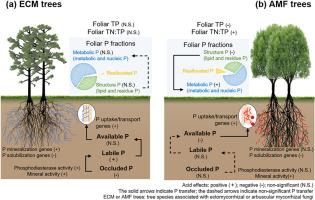Tropical tree-mycorrhizal types show divergent phosphorus adaptive strategies after 12-year simulated acid rain
IF 10.3
1区 农林科学
Q1 SOIL SCIENCE
引用次数: 0
Abstract
Acid rain is believed to exacerbate phosphorus (P) limitation in tropical forests, but how tropical trees respond and adapt to acid-induced P limitation, particularly after long-term acid rain events, remains poorly understood. We conducted a 12-year simulated acid rain (SAR) experiment by irrigating plots with water of different pH values (i.e., 3.0, 3.5, 4.0, and 4.5 as a control) in a tropical forest in southern China. Five tree species associated with either ectomycorrhizal (ECM) or arbuscular mycorrhizal fungi (AMF) were chosen to examine the changes of P fractions in their rhizosphere soils and green leaves. In ECM tree rhizospheres, SAR treatments significantly increased labile P by 27.3 % (p < 0.05) and decreased occluded P by 11.7 % (p < 0.05), which were positively correlated with increased phosphodiesterase activity and related gene abundance. However, in AMF trees, SAR treatments significantly reduced rhizosphere available P and foliar P by 45.9 % and 28.7 % (p < 0.05 for both), respectively. In response, AMF trees exhibited greater plasticity in foliar P fractions than ECM trees, shifting from structural P (phospholipids and phosphorylated proteins) to metabolic P (P-containing metabolites and nucleic acid P) fractions under SAR treatments. These findings suggest that, to cope with acid-induced P limitation, ECM trees tend to adopt an acquisitive nutrient-use strategy for greater P mobilization, while AMF trees favor a conservative strategy with more efficient foliar P utilization.


热带树木菌根类型在12年模拟酸雨后表现出不同的磷适应策略
酸雨被认为加剧了热带森林的磷(P)限制,但热带树木如何响应和适应酸诱导的磷限制,特别是在长期酸雨事件之后,仍然知之甚少。在中国南方热带森林进行了为期12年的模拟酸雨(SAR)试验,采用不同pH值(即3.0、3.5、4.0和4.5作为对照)的水进行灌溉。选择与外生菌根真菌(ECM)或丛枝菌根真菌(AMF)相关的5种树种,研究其根际土壤和绿叶中磷组分的变化。在ECM树根际,SAR处理显著提高了活性磷27.3% (P < 0.05),显著降低了封闭磷11.7% (P < 0.05),这与磷酸二酯酶活性和相关基因丰度的升高呈正相关。然而,在AMF树木中,SAR处理显著降低了根际有效磷和叶面磷,分别降低了45.9%和28.7% (P < 0.05)。在SAR处理下,AMF树的叶片P组分表现出比ECM树更强的可塑性,从结构P(磷脂和磷酸化蛋白)转向代谢P(含P代谢物和核酸P)组分。这些结果表明,为了应对酸诱导的磷限制,ECM树倾向于采取获取性养分利用策略来动员更多的磷,而AMF树倾向于采取保守策略,更有效地利用叶面磷。
本文章由计算机程序翻译,如有差异,请以英文原文为准。
求助全文
约1分钟内获得全文
求助全文
来源期刊

Soil Biology & Biochemistry
农林科学-土壤科学
CiteScore
16.90
自引率
9.30%
发文量
312
审稿时长
49 days
期刊介绍:
Soil Biology & Biochemistry publishes original research articles of international significance focusing on biological processes in soil and their applications to soil and environmental quality. Major topics include the ecology and biochemical processes of soil organisms, their effects on the environment, and interactions with plants. The journal also welcomes state-of-the-art reviews and discussions on contemporary research in soil biology and biochemistry.
 求助内容:
求助内容: 应助结果提醒方式:
应助结果提醒方式:


